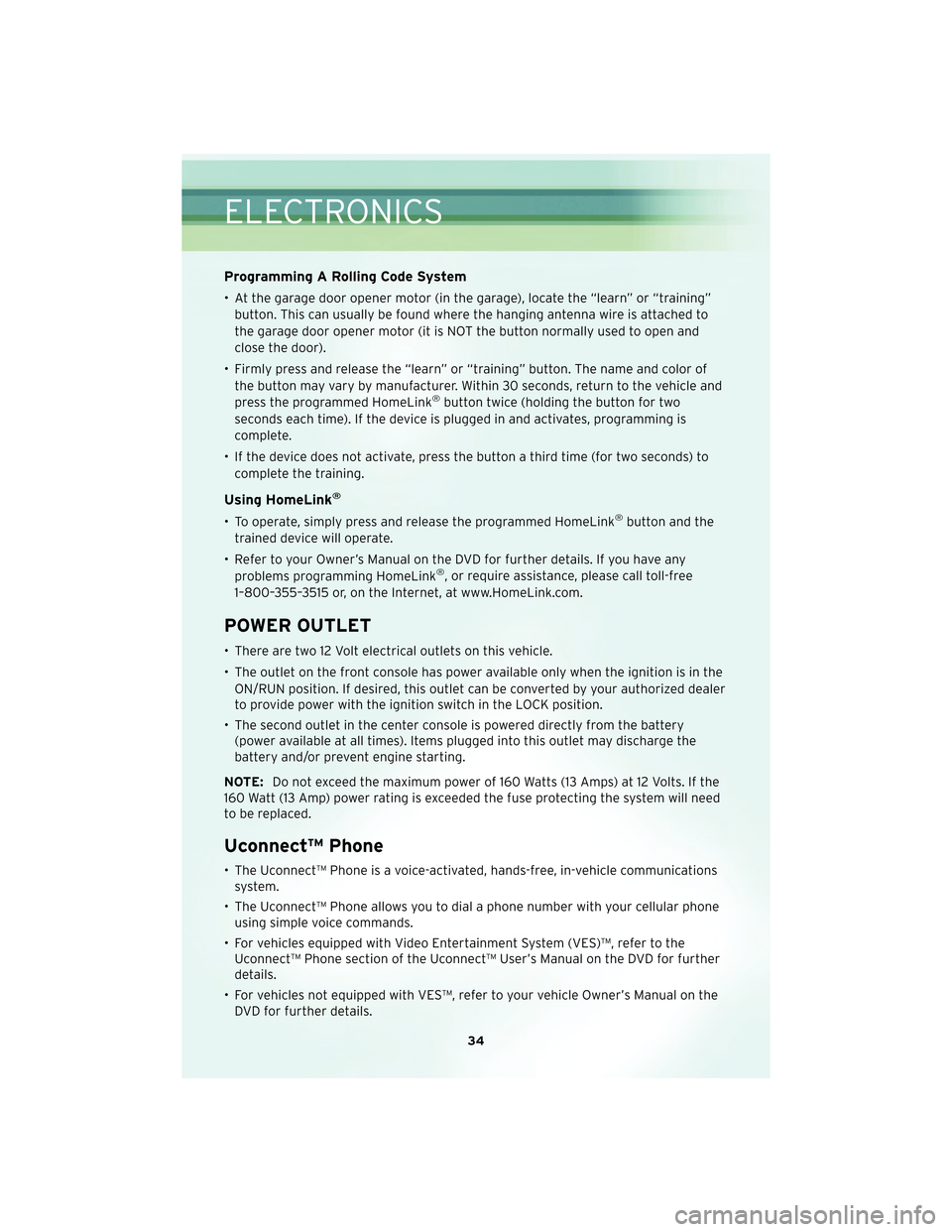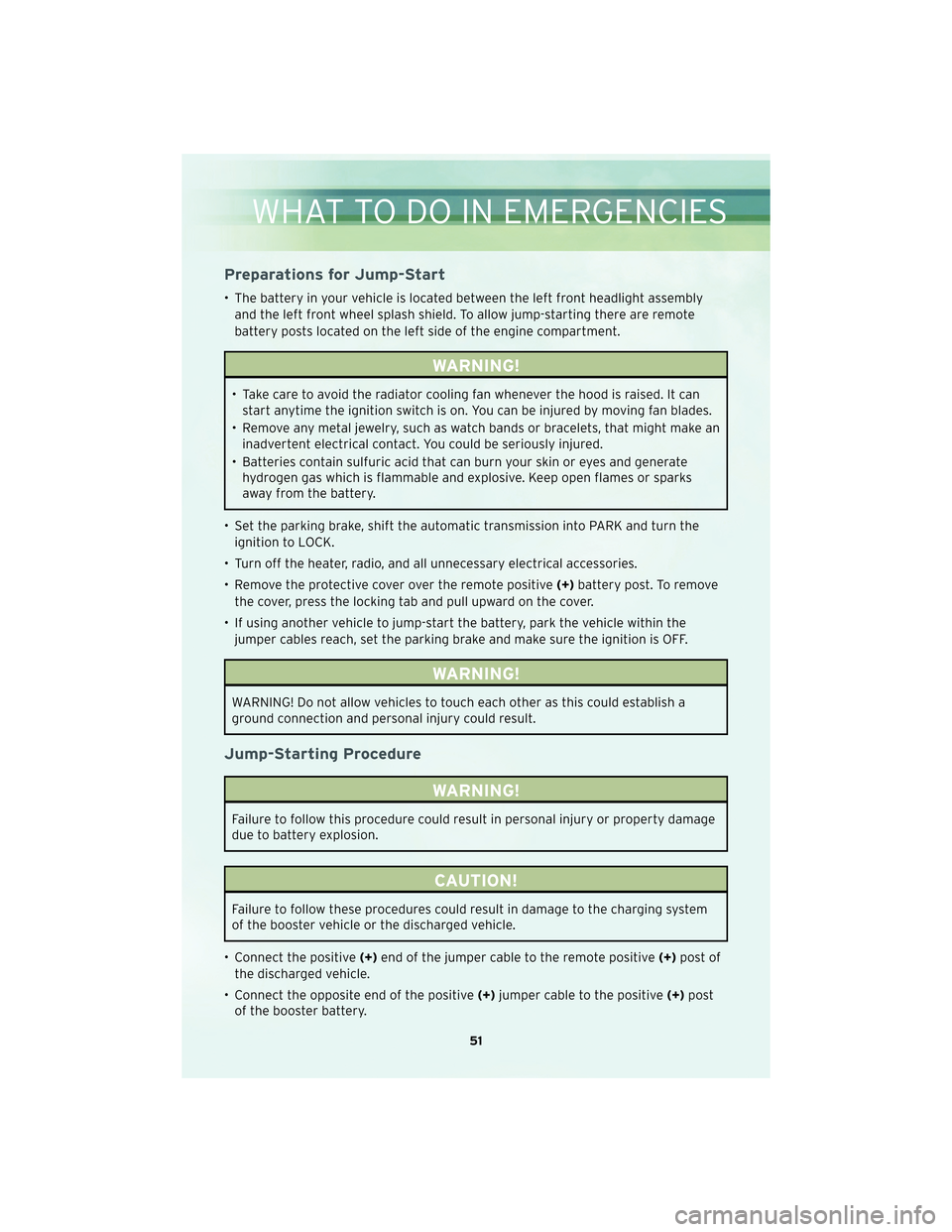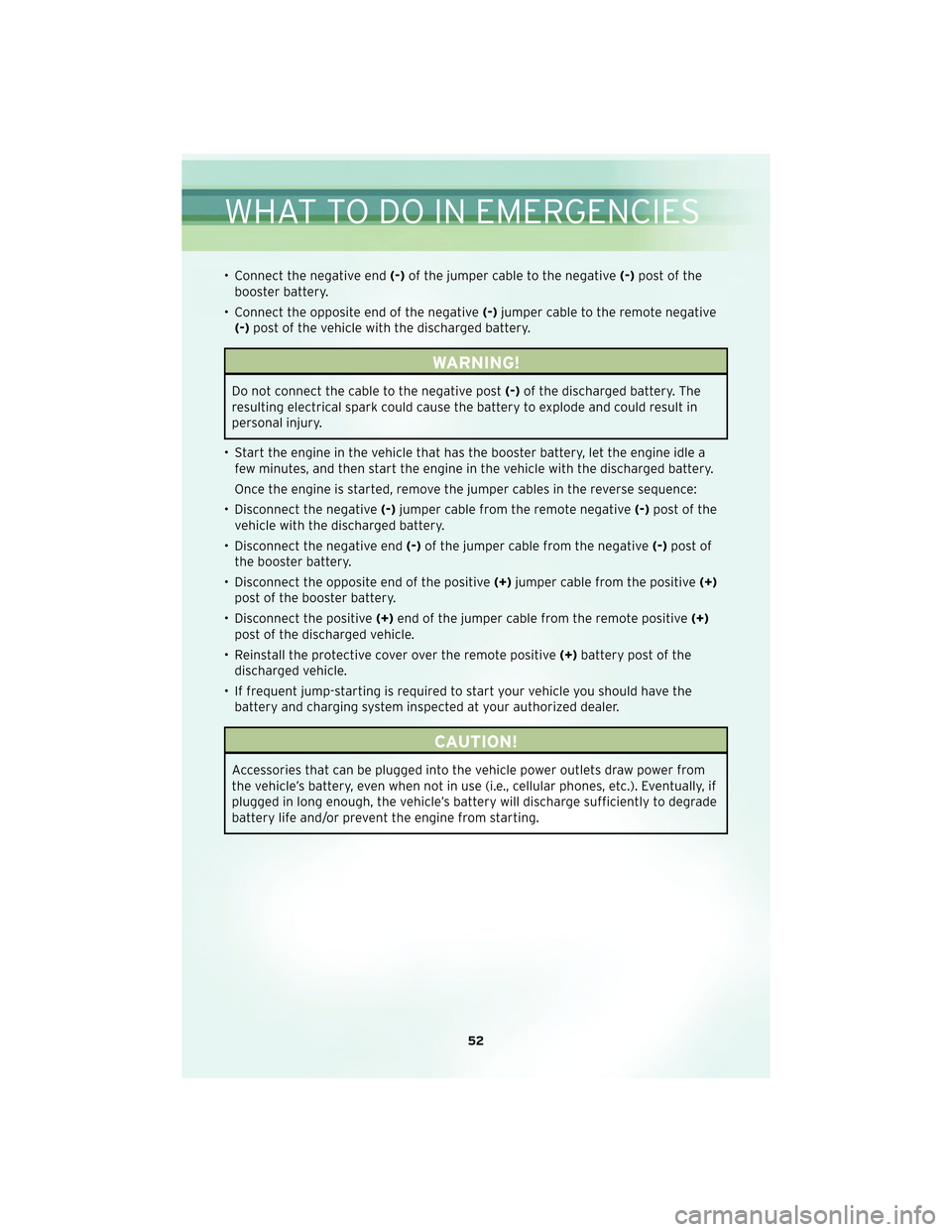battery CHRYSLER SEBRING CONVERTIBLE 2010 3.G User Guide
[x] Cancel search | Manufacturer: CHRYSLER, Model Year: 2010, Model line: SEBRING CONVERTIBLE, Model: CHRYSLER SEBRING CONVERTIBLE 2010 3.GPages: 76, PDF Size: 9.67 MB
Page 36 of 76

Programming A Rolling Code System
• At the garage door opener motor (in the garage), locate the “learn” or “training”button. This can usually be found where the hanging antenna wire is attached to
the garage door opener motor (it is NOT the button normally used to open and
close the door).
• Firmly press and release the “learn” or “training” button. The name and color of the button may vary by manufacturer. Within 30 seconds, return to the vehicle and
press the programmed HomeLink
®button twice (holding the button for two
seconds each time). If the device is plugged in and activates, programming is
complete.
• If the device does not activate, press the button a third time (for two seconds) to complete the training.
Using HomeLink®
• To operate, simply press and release the programmed HomeLink®button and the
trained device will operate.
• Refer to your Owner’s Manual on the DVD for further details. If you have any problems programming HomeLink
®, or require assistance, please call toll-free
1–800–355–3515 or, on the Internet, at www.HomeLink.com.
POWER OUTLET
• There are two 12 Volt electrical outlets on this vehicle.
• The outlet on the front console has power available only when the ignition is in the ON/RUN position. If desired, this outlet can be converted by your authorized dealer
to provide power with the ignition switch in the LOCK position.
• The second outlet in the center console is powered directly from the battery (power available at all times). Items plugged into this outlet may discharge the
battery and/or prevent engine starting.
NOTE: Do not exceed the maximum power of 160 Watts (13 Amps) at 12 Volts. If the
160 Watt (13 Amp) power rating is exceeded the fuse protecting the system will need
to be replaced.
Uconnect™ Phone
• The Uconnect™ Phone is a voice-activated, hands-free, in-vehicle communications system.
• The Uconnect™ Phone allows you to dial a phone number with your cellular phone using simple voice commands.
• For vehicles equipped with Video Entertainment System (VES)™, refer to the Uconnect™ Phone section of the Uconnect™ User’s Manual on the DVD for further
details.
• For vehicles not equipped with VES™, refer to your vehicle Owner’s Manual on the DVD for further details.
ELECTRONICS
34
Page 52 of 76

JUMP-STARTING
• If your vehicle has a discharged battery it can be jump-started using a set ofjumper cables and a battery in another vehicle or by using a portable battery
booster pack.
• Jump-starting can be dangerous if done improperly so please follow the procedures in this section carefully.
NOTE: When using a portable battery booster pack follow the manufacturer’s
operating instructions and precautions.
CAUTION!
Do not use a portable battery booster pack or any other booster source with a
system voltage greater than 12 Volts or damage to the battery, starter motor,
alternator or electrical system may occur.
WARNING!
When temperatures are below the freezing point, electrolyte in a discharged
battery may freeze. Do not attempt jump-starting because the battery could
rupture or explode and cause personal injury. Battery temperature must be
brought above the freezing point before attempting a jump-start.
WHAT TO DO IN EMERGENCIES
50
Page 53 of 76

Preparations for Jump-Start
• The battery in your vehicle is located between the left front headlight assemblyand the left front wheel splash shield. To allow jump-starting there are remote
battery posts located on the left side of the engine compartment.
WARNING!
• Take care to avoid the radiator cooling fan whenever the hood is raised. It canstart anytime the ignition switch is on. You can be injured by moving fan blades.
• Remove any metal jewelry, such as watch bands or bracelets, that might make an inadvertent electrical contact. You could be seriously injured.
• Batteries contain sulfuric acid that can burn your skin or eyes and generate hydrogen gas which is flammable and explosive. Keep open flames or sparks
away from the battery.
• Set the parking brake, shift the automatic transmission into PARK and turn the ignition to LOCK.
• Turn off the heater, radio, and all unnecessaryelectrical acc essories.
• Remove the protective cover over the remote positive (+)battery post. To remove
the cover, press the locking tab and pull upward on the cover.
• If using another vehicle to jump-start the battery, park the vehicle within the jumper cables reach, set the parking brake and make sure the ignition is OFF.
WARNING!
WARNING! Do not allow vehicles to touch each other as this could establish a
ground connection and personal injury could result.
Jump-Starting Procedure
WARNING!
Failure to follow this procedure could result in personal injury or property damage
due to battery explosion.
CAUTION!
Failure to follow these procedures could result in damage to the charging system
of the booster vehicle or the discharged vehicle.
• Connect the positive (+)end of the jumper cable to the remote positive (+)post of
the discharged vehicle.
• Connect the opposite end of the positive (+)jumper cable to the positive (+)post
of the booster battery.
51
WHAT TO DO IN EMERGENCIES
Page 54 of 76

• Connect the negative end(-)of the jumper cable to the negative (-)post of the
booster battery.
• Connect the opposite end of the negative (-)jumper cable to the remote negative
(-) post of the vehicle with the discharged battery.
WARNING!
Do not connect the cable to the negative post (-)of the discharged battery. The
resulting electrical spark could cause the battery to explode and could result in
personal injury.
• Start the engine in the vehicle that has the booster battery, let the engine idle a few minutes, and then start the engine in the vehicle with the discharged battery.
Once the engine is started, remove the jumper cables in the reverse sequence:
• Disconnect the negative (-)jumper cable from the remote negative (-)post of the
vehicle with the discharged battery.
• Disconnect the negative end (-)of the jumper cable from the negative (-)post of
the booster battery.
• Disconnect the opposite end of the positive (+)jumper cable from the positive (+)
post of the booster battery.
• Disconnect the positive (+)end of the jumper cable from the remote positive (+)
post of the discharged vehicle.
• Reinstall the protective cover over the remote positive (+)battery post of the
discharged vehicle.
• If frequent jump-starting is required to start your vehicle you should have the battery and charging system inspected at your authorized dealer.
CAUTION!
Accessories that can be plugged into the vehicle power outlets draw power from
the vehicle’s battery, even when not in use (i.e., cellular phones, etc.). Eventually, if
plugged in long enough, the vehicle’s battery will discharge sufficiently to degrade
battery life and/or prevent the engine from starting.
WHAT TO DO IN EMERGENCIES
52
Page 57 of 76

EVENT DATA RECORDER (EDR)
• In the event of an accident, your vehicle is designed to record up to five seconds ofspecific vehicle data parameters (see list below) in an event data recorder prior to
the moment of airbag deployment, or near deployment (if applicable), and up to a
quarter second of either high-speed deceleration data or change in velocity during
and/or after airbag deployment or near-deployment. EDR data is ONLY recorded if
an airbag deploys, or nearly deploys, and is otherwise unavailable.
NOTE:
• A near-deployment event occurs when the airbag sensor detects severe vehicle deceleration usually indicative of a crash, but not severe enough to warrant airbag
deployment.
• Under certain circumstances, EDR data may not be recorded (e.g., loss of battery power).
• In conjunction with other data gathered during a complete accident investigation, the electronic data may be used by Chrysler Group LLC and others to learn more
about the possible cau ses of crashesand associated injuries i n order toassessand
improve vehicle performance. In addition to crash investigations initiated by
Chrysler Group LLC, such investigations may be requested by customers, insurance
carriers, government officials, and professional crash researchers, such as those
associated with universities, and with hospital and insurance organizations.
• In the event that an investigation is undertaken by Chrysler Group LLC (regardless of initiative), the company or its designated representative will first obtain
permission of the appropriate custodial entity for the vehicle (usually the vehicle
owner or lessee) before accessing the electronic data stor ed, unlessordered to
image the data by a court with legal jurisdiction (i.e., pursuant to a warrant). A copy
of the data will be provided to the cust odial entity upon request.General data that
does not identify particular vehicles or crashes may be released for incorporation
in aggregate crash databases, such as those maintained by the U.S. government
and various states. Data of a potentially sensitive nature, such as would identify a
particular driver, vehicle, or crash, will be tr eated confidentially. Confidential data
will not be disclosed by Chrysler Group LLC to any third party except when:
• Used for resear ch purposes, such as to match data with a particular crash record
in an aggregate database, provided confidentiality of personal data is thereafter
preserved.
• Used in defense of litigation involving a Chrysler Group LLC product.
• Requested by police under a legal warrant.
• Otherwise required by law.
Data parameters that are recorded:
• Diagnostic trouble code(s) and warning light status for electronically-controlled safety systems, including the airbag system.
• Vehicle speed, Engine RPM, Brake switch status, Pedal position, and other parameters depending on vehicle configuration.
55
WHAT TO DO IN EMERGENCIES
Page 66 of 76

FUSES
Totally Integrated Power Module (TIPM)
• The Totally Integrated Power Module (TIPM) is located in the engine compartmentnear the air cleaner assembly. This center contains cartridge fuses and mini fuses.
Cavity Cartridge Fuse Mini Fuse Description
1 40 Amp Green Power Top Module (If Equipped)
2 20 Amp Yellow AWD Module
3 10 Amp RedBattery Feed — Center High
Mounted Stop Light (CHMSL)/
Brake Switch
4 10 Amp Red Battery Feed — Ignition Switch
5 20 Amp Yellow Trailer Tow — If Equipped
6 10 Amp RedIgnition Off Draw (IOD) — Power
Mirror Switch/Climate Controls
7 30 Amp Green Ignition Off Draw (IOD) Sense 1
8 30 Amp Green Ignition Off Draw (IOD) Sense 2
9 40 Amp Green BatteryFeed—PowerSeats-if
equipped/PZEV Air Pump - if
equipped
10 20 Amp YellowBattery Feed — Cabin Compartment
Node (CCN)
11 15 Amp Lt. Blue Selectable Power Outlet
12 20 Amp Yellow —
13 20 Amp Yellow —
14 10 Amp RedIgnition Off Draw (IOD) — Cabin
Compartment Node (CCN)/ Interior
Lighting
15 40 Amp Green Battery Feed — Radiator Fan Relay
16 15 Amp Lt. BlueIGN Run/ACC — Cigar Lighter/PWR
Sunroof Mod
MAINTAINING YOUR VEHICLE
64
Page 67 of 76

Cavity Cartridge Fuse Mini FuseDescription
17 10 Amp RedIgnition Off Draw (IOD) — Wireless
Control Module (WCM)/Clock/
Steering Control Module (SCM)
18 40 Amp Green Battery Feed — Auto Shutdown
(ASD) Relay
19 20 Amp YellowIgnition Off Draw (IOD) — Power
AmpFeed2-ifequipped
20 15 Amp Lt. Blue Ignition Off Draw (IOD) — Radio
21 10 Amp Red —
22 10 Amp RedIgnition Run — Climate
Controls/Hot Cupholder - if
equipped
23 15 Amp Lt. Blue Auto Shutdown (ASD) Relay Feed 3
24 25 Amp Natural Battery Feed — PWR Sunroof Feed
25 10 Amp RedIgnition Run — Heated Mirrors - If
Equipped
26 15 Amp Lt. Blue Auto Shutdown (ASD) Relay Feed 2
27 10 Amp RedIgnition Run — Occupant
Classification Module
(OCM)/Occupant Restraint
Controller (ORC)
28 10 Amp RedIgnition Run — Occupant
Classification Module
(OCM)/Occupant Restraint
Controller (ORC)
29 — — Hot Car (No Fuse Required)
30 20 Amp YellowIgnition Run — Heated Seats - If
Equipped
31 10 Amp Red —
32 30 Amp Pink Auto Shutdown (ASD) Relay Feed 1
33 10 Amp RedBattery Feed — Switch
Bank/Diagnostic Link
Connector/Powertrain Control
Module (PCM)
34 30 Amp Pink Battery Feed — Anti-Lock Brakes
(ABS) Module - if equipped/
Electronic Stability Program (ESC)
Module - If Equipped
35 40 Amp Green Battery Feed — Anti-Lock Brakes
(ABS) Module - If Equipped/
Electronic Stability Program (ESC)
Module - If Equipped
36 30 Amp Pink Battery Feed — Passenger Door
Module (PDM)/Driver Door Module
(DDM)
37 25 Amp Natural Power Top Module (If Equipped)
65
MAINTAINING YOUR VEHICLE